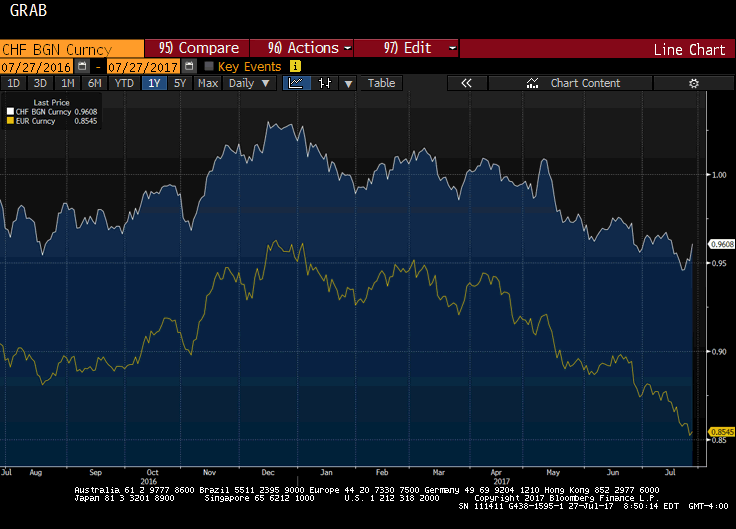Summary: Swiss franc weakness is a function of the demand for euros. SNB indicates it will lag behind the other major central banks in normalization process. Easing of political anxiety in Europe is also negative for the franc. The Swiss franc is trading at its lowest level against the euro since the Swiss National Bank surprised the world by lifting the currency cap in early 2015. This week’s move has been especially pronounced. The euro has appreciated by a little more than 2% against the franc, Barring much of a setback tomorrow, it will be the largest weekly advance in 2 1/2 years. The euro and the Swiss franc are highly correlated. Over the past 60-days, the correlation of percentage change of the
Topics:
Marc Chandler considers the following as important: CHF, EUR, Featured, Great Graphic, newsletter
This could be interesting, too:
Nachrichten Ticker - www.finanzen.ch writes Die Performance der Kryptowährungen in KW 9: Das hat sich bei Bitcoin, Ether & Co. getan
Nachrichten Ticker - www.finanzen.ch writes Wer verbirgt sich hinter der Ethereum-Technologie?
Martin Hartmann writes Eine Analyse nach den Lehren von Milton Friedman
Marc Chandler writes March 2025 Monthly
Summary:
Swiss franc weakness is a function of the demand for euros.
SNB indicates it will lag behind the other major central banks in normalization process.
Easing of political anxiety in Europe is also negative for the franc.
| The Swiss franc is trading at its lowest level against the euro since the Swiss National Bank surprised the world by lifting the currency cap in early 2015. This week’s move has been especially pronounced. The euro has appreciated by a little more than 2% against the franc, Barring much of a setback tomorrow, it will be the largest weekly advance in 2 1/2 years.
The euro and the Swiss franc are highly correlated. Over the past 60-days, the correlation of percentage change of the two currencies is 0.85. For the past two years, the rolling 60-day correlation has not fallen below 0.75 and rarely moves above 0.90. That makes this week’s development all the more eye-catching. The franc has fallen 1.6% against the US dollar (~CHF0.9615), while the euro has risen 0.4% (~$1.1695). The euro reached a new 30-month high today, edging briefly above $1.1775. The dollar bottomed against the Swiss franc last week (July 21) near CHF0.9440. Today it is posting a potential outside up day. The dollar briefly fell through yesterday’s lows in Asia and now has rallied above yesterday’s high. A close above yesterday’s high(almost CHF0.96) would be a bullish technical development. This Great Graphic, created on Bloomberg, shows this on a line chart. The dollar’s performance against the franc over the past year, including its recent turn higher, is shown in the white chart. To show the euro in an intuitively clearer way, so we took the inverse of how it is typically quoted. The decline shown in the chart is the decline of the dollar against the euro. |
Swiss Franc Currency |
The $2 mln question is if the Swiss franc is a lead indicator of the euro. Over the past year, it appears that, to the contrary, it is the euro that leads the Swiss franc. The euro is not just gaining against the dollar and Swiss franc, but it is also appreciated against the yen and sterling. The euro strength, the evolving ECB policy toward altering its risk assessment and likely the pace of its asset purchases is sucking in capital from other major financial centers.
At the same time, the Swiss National Bank, like the Bank of Japan, has indicated that it will lag behind the other major central banks. SNB President Jordan continues to complain about the overvaluation of the Swiss franc. The OECD calculates that the Swiss franc ($1=CHF0.9600), is 23% over-valued, the most in the OECD’s universe. The SNB has hardly broached the topic unwinding the rate cuts that brought the deposit rate to minus 75 bp. Swiss (generic) yields are negative out 9-10 years.
Swiss equities are up 10% year-to-date, which is comparable to the US, but above the performance of core bourses, but trailing the 12.5%-13.2% gain in Italy and Spain. However, there are still incentives for Swiss savings to be exported. And given the preference for foreign fixed income, high currency hedge ratios appear to be the customary practice. No one can afford to be bitten by the same dog twice, and in light of the sharp appreciation of the franc following the removal of the cap, high hedge ratios were likely maintained. However, with franc weakening and the adverse rate movements, franc buying hedge is becoming more costs and, arguably less desirable.
Although the consensus narrative emphasizes the ECB tapering and the doubts over whether the Fed will raise interest rates again this year, the turning point for the euro came when it became clear that the populist-nationalist wave was going to be turned back in France. The easing of the political anxiety, which was a key theme in the 2017 outlook pieces, also has removed a prop for the franc.
We do not think the franc’s losses against the dollar is a convincing sign that the euro is about to turn lower. We suspect the franc’s weakness is a reflection of euro strength that is being seen against several other major currencies. That said, we are closely monitoring the interest rate differential between the US and Germany. At 203 bp, the two-year US premium is at its highest level in a month, and the 10-year premium of 177 bp is the most since two weeks. If the premium continues to trend in the US favor, the dollar may get better traction. Still, we recognize that the US policy uncertainty may encourage investors to demand a greater interest rate premium. In turn, this means that a wider differential than previously is needed to support any dollar level.
Tags: $CHF,$EUR,Featured,Great Graphic,newsletter

